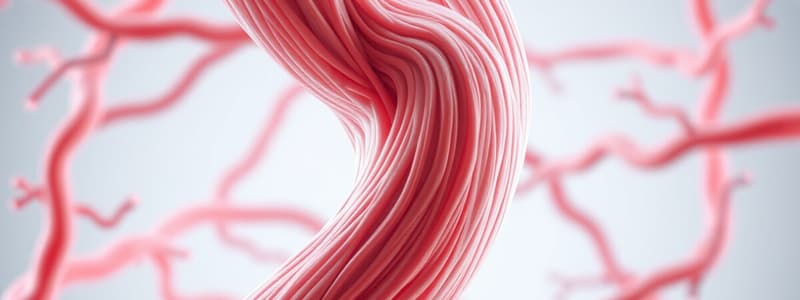Podcast
Questions and Answers
What role do calcium ions play in muscle contraction?
What role do calcium ions play in muscle contraction?
- They initiate the decomposition of ATP.
- They directly bind to actin filaments.
- They bind to troponin, changing its shape. (correct)
- They decrease the energy available for contraction.
What happens to the tropomyosin when calcium ions bind to troponin?
What happens to the tropomyosin when calcium ions bind to troponin?
- It enhances the contraction strength.
- It becomes more rigid and anchors the actin.
- It is pulled away from the binding site. (correct)
- It directly binds to the myosin head.
What is the function of ATP in muscle contraction?
What is the function of ATP in muscle contraction?
- It is used to directly contract the muscle fibers.
- It is required to bind myosin to actin.
- It provides energy for the movement of the myosin head. (correct)
- It reduces calcium ion concentrations.
How does the actin-myosin cross bridge form?
How does the actin-myosin cross bridge form?
What enzyme is activated by calcium ions during muscle contraction?
What enzyme is activated by calcium ions during muscle contraction?
What occurs after the myosin head moves the actin filament?
What occurs after the myosin head moves the actin filament?
What is the nature of the bond formed between actin and myosin?
What is the nature of the bond formed between actin and myosin?
What initial event leads to the release of calcium ions from the sarcoplasmic reticulum?
What initial event leads to the release of calcium ions from the sarcoplasmic reticulum?
What mechanism describes the movement of the myosin head during contraction?
What mechanism describes the movement of the myosin head during contraction?
What is the primary protein component of thick myofilaments?
What is the primary protein component of thick myofilaments?
What marks the ends of each sarcomere?
What marks the ends of each sarcomere?
What happens to the actin-myosin binding site during muscle relaxation?
What happens to the actin-myosin binding site during muscle relaxation?
Which zone in the sarcomere contains only thick myofilaments?
Which zone in the sarcomere contains only thick myofilaments?
When an action potential stimulates a muscle cell, what ions are released from the sarcoplasmic reticulum?
When an action potential stimulates a muscle cell, what ions are released from the sarcoplasmic reticulum?
What is the role of tropomyosin in muscle contraction?
What is the role of tropomyosin in muscle contraction?
What structural feature allows myosin heads to bind to actin?
What structural feature allows myosin heads to bind to actin?
How do myofilaments contribute to muscle contraction?
How do myofilaments contribute to muscle contraction?
What is the immediate effect of calcium ions binding to troponin during muscle contraction?
What is the immediate effect of calcium ions binding to troponin during muscle contraction?
What structure indicates the middle of the myosin filaments in a sarcomere?
What structure indicates the middle of the myosin filaments in a sarcomere?
Flashcards are hidden until you start studying
Study Notes
Myofibrils and Muscle Contraction
- Myofibrils consist of thick and thin myofilaments that slide over one another to facilitate muscle contraction.
- Thick myofilaments are primarily composed of myosin, while thin myofilaments are made of actin.
- Electron microscopy reveals a pattern of alternating dark (A-bands) and light (I-bands) bands in myofibrils due to the arrangement of myofilaments.
Sarcomeres Structure
- Myofibrils are organized into repeating units known as sarcomeres, which are the fundamental contractile units.
- Each sarcomere begins and ends at Z-lines, which mark the boundaries and join adjacent sarcomeres lengthwise.
- The M-line runs through the center of each sarcomere, aligning with the thick myosin filaments.
Mechanism of Contraction
- Muscle contractions occur when myosin and actin filaments slide over one another, shortening the sarcomeres without changing the length of the filaments.
- The simultaneous contraction of multiple sarcomeres leads to the contraction of myofibrils and overall muscle fibers.
- Relaxation of the muscle returns sarcomeres to their original length.
Myosin and Actin Interaction
- Myosin filaments feature globular heads that can hinge, allowing for movement.
- Each myosin head has binding sites for actin and ATP, facilitating muscle contraction.
- Actin filaments possess specific binding sites for myosin, known as actin-myosin binding sites.
Regulatory Proteins: Tropomyosin and Troponin
- Tropomyosin and troponin are regulatory proteins that inhibit the interaction between actin and myosin in resting muscles.
- In a relaxed state, tropomyosin blocks the actin-myosin binding sites, preventing myosin heads from binding to actin.
Role of Calcium Ions in Muscle Activation
- An action potential from a motor neuron initiates muscle cell depolarization, transmitting along the T-tubules.
- Depolarization triggers the release of calcium ions (Ca²⁺) from the sarcoplasmic reticulum into the sarcoplasm.
- Calcium binds to troponin, causing a conformational change that pulls tropomyosin away from the binding sites on actin.
- The exposure of actin-myosin binding sites enables myosin heads to attach.
Actin-Myosin Cross Bridge
- The connection formed when a myosin head attaches to an actin filament is known as an actin-myosin cross bridge.
- This binding is crucial for muscle contraction and subsequent movement of the actin filament.
Energy Supply for Contraction
- ATP is necessary for muscle contraction, providing energy by breaking down into ADP and inorganic phosphate (Pi) through the action of ATPase.
- The energy derived from ATP allows the myosin head to pivot and pull the actin filament in a rowing motion, facilitating contraction.
Studying That Suits You
Use AI to generate personalized quizzes and flashcards to suit your learning preferences.




